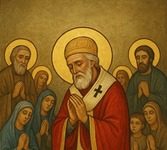Understanding The Lebanese Distinguishable Identity
(Courtesy of Cedarland)
A great deal of debate has gone on regarding the identity of the Lebanese, many state that the Lebanese are Arabs and that Lebanon is an Arab state, whilst many argue that this is not the case, that the Lebanese are not Arab. In the Lebanese constitution (not the Taef Accord imposed in 1988), the word Arab does not appear, the constitution only makes reference to Arabic as being the official language in article 11, yet this seemingly trivial matter was deemed of such importance that an entire sentence stating that Lebanon is Arab was inserted at the beginning of the Taif agreement in 1990. The contribution of the Arabs to the development of mankind cannot be ignored, as it was truly immense in its proportion. In almost every field the Europeans learnt much from their eastern neighbours. In medicine, astronomy, chemistry, physics, geography, mathematics, and architecture the Europeans drew heavily from Arabic books. In industry the Europeans learned of the processes used by the Arabs in paper making, leather working, and textile manufacture. It seems that it would be an honour for any country to be identified as Arab, however one cannot simply state that one is an Arab just for the sake of it, similarly one cannot state that an entire country is Arab just because he wishes to please his neighbours. In order to answer the question of Lebanese identity one has to look into the history of Lebanon so as to determine the origin of its inhabitants.
The earliest recorded texts refer to the inhabitants of Lebanon as Canaanites. Philo of Byblos claims that the Canaanites were autochthonous, i.e. inhabiting the region from the earliest times, and that they were not only men but also gods and the whole human culture hail from their area. However many theories involving migration have been put forward as to Canaanite origins, which range form Eritrea, the Sinai, the Persian Gulf or as far away as Antarctica. Herodotus locates them on the Eritrean sea and Justin tells how they were driven from their original land by an earthquake and settled first on the coast of the Dead Sea and then on the Mediterranean. For migration theories to make sense they must presuppose that some kind of ‘nation’ must have existed for the Canaanites to migrate from before their appearance in the area of Lebanon but there is no historical or archaeological evidence for such a ‘nation’.
Evidence of human settlement in Lebanon dates back to the Palaeolithic period when man was differentiated from other animals by little more than the simple tools he was able to make. It was at the end of the last glaciation around 10,000 B.C. a period known as the Mesolithic, that mankind took an enormous step forward by cultivating plants and domesticating animals. Archaeologists have proven that this process began in what is known as the Fertile Crescent an area comprising the Nile Valley, Israel, Lebanon, Syria and Iraq. It was around this time that small towns started to appear, the oldest in the world being Jericho in Israel and Byblos in Lebanon going back to at least 9000 B.C. as shown by carbon-14 dating. By 8000 B.C. these Canaanite towns had populations of between 2000 and 4000.
Canaanites are described as a Semitic people. The term Semitic ot Semite is frequently used and it is important to understand what it means as it applies to a number of peoples. The following definitions are found:
Se•mit•ic
-n
Pronunciation: (su-mit’ik),
a subfamily of Afroasiatic languages that includes Akkadian, Arabic, Aramaic, Ethiopic, Hebrew, and Phoenician.
—adj.
of or pertaining to the Semites or their languages, esp. of or pertaining to the Jews
Sem•ite
Pronunciation: (sem’It or, esp. Brit., sE’mIt),
—n.
1. a member of any of various ancient and modern peoples originating in Asia, including the Akkadians, Canaanites, Hebrews, and Arabs. These peoples are grouped under the term Semite, chiefly because their languages were found to be related, deriving presumably from a common tongue, Semitic.
2. a member of any of the peoples descended from Shem, the eldest son of Noah.
3. a Jew.
The Canaanite language was indeed Semitic as per the first definition, however the Canaanites were not the descendants of Shem. According to Genesis, Noah had three children, Shem, Ham, and Japheth. The eldest son of Noah, Shem, is the traditional ancestor of Semites (Genesis 10); descendants include Hebrews, Aramaeans, and Arabs. Ham is biblical ancestor of Hamites, who included the Cushites, the Canaanites, and the Egyptians (Genesis. 8;9). According to tradition the descendants of Japheth inhabited Europe and Asia Minor along the Mediterranean coast. Ham had a son called Canaan who in turn had one called Sidon (Genesis 10;15). These decedents of Canaan, the Canaanites lived on the coast of the eastern Mediterranean (Genesis 10;19).
The Canaanites who lived in what is now present day Lebanon were later called the Phoenicians by the Greeks c. 10th century B.C. The Phoenicians are well known as having been great benefactors to mankind.
From the dawn of recorded history Lebanon has swung between independence and occupation. Long periods of independence were interrupted by Assyrian rule, then Babylonian and Persian rule, then by Alexander and by 64 BC Lebanon had become part of the Roman Empire. Throughout these years, the original native inhabitants of Lebanon were not displaced nor were they diluted, their Levantine, Canaanite origin remained intact.
It was in Roman times that a carpenter’s son who was born in a stable was to forever change world. News of the teachings of this Jesus of Nazareth was to reach Lebanon early in his ministry and it prompted people from Lebanon to go and visit him (Mk. 3:8, Lk. 6:17), and he was also to journey to Lebanon where he healed the daughter of a Phoenician woman (Matt.15:21-8, Mk. 7:24-31) and attended a wedding. After the death of Christ, upon the martyrdom of Stephen, some of the disciples that were scattered abroad to preach went north to Phoenicia (Acts 11:19), through their works and the work of Paul, Lebanon converted. The pagan Canaanites, the early Lebanese, became Christian. Christianity flourished in Lebanon and by the close of the second century Tyre had become the seat of a Christian Bishop as has Sidon, whose Bishop attended the council of Nicea in 325 in which the Nicene Creed was formulated, furthermore in the year 335 a church council was held in Tyre. At about the same time, Frumentius, a Tyrian missionary introduced Christianity to Ethiopia. From early in the 5th Century and throughout the 6th, through the works of the disciples of St. Maron the people of Lebanon, the Phoenicians, joined the Maronite Church.
For many years the Maronite Lebanese worked the land, terraced the mountains built their villages and expanded their cities. Soon a human tidal wave was not only to change the demographics of Lebanon but was also to change the history of the civilized world.
In a little know area of a Byzantine province in 570 AD was born, to a camel trading father, a child known to history by his honorific name Mohammed, or ‘highly praised’. The religion founded by Mohammed in Arabia was that of Islam, and he is regarded by his followers as a prophet. The book he, an unschooled man produced, was written by one of his followers and is considered by the Islam (Muslims) to be the literal word of God told to Mohammed by the Angel Gabriel. By the time he died in 632, Mohammed had converted the Arabian peninsula, mainly by the sword, to Islam.
In 633, a year after Mohammed’s death, in a valley just south of the Dead Sea, a group of Arabian Muslims fought their first battle outside of Arabia against the Byzantines. By 637 almost the entire Middle East had fallen into Arab hands. The victory of Islam was in three parts: Islam the state; Islam the religion; and Islam the language, Arabic.
Lebanon, however, remained a Christian island in a sea of Islam. It is in Lebanon that Islam the state did not govern, Islam the religion did not convert, and Islam the language did not take over from Aramaic Syriac for over a thousand years, and even then never as a spoken language but as the written one. In Lebanon today there is a huge difference between the spoken Lebanese and the written Arabic, Lebanese being a mixture rich in Syriac. A great part of the coastal population of Lebanon joined their fellow Christian countrymen high in the mountains out of Arab reach. The mountains offered no attraction to the desert Arabs, agriculture was considered below their dignity and and they knew little of industry and even less about maritime trade. The Arabs did not realize the strategic importance of Lebanon and they left it to itself and so opened the way for Byzantine naval raids. Such incursions were a prime reason why an inland seat of government, Damascus, was chosen by the Arabs. As a result of the coastal inhabitants of Lebanon refusing to convert and moving to the mountains the Lebanese coast was left undefended and so it became necessary for Muawiyah the Caliph, in 663, to transplant Persians and Arabians to the Lebanese coast so as to provide a measure of protection against naval incursions by the Byzantines.
By the end of the 7th century the Arabs and the Persians, newcomers to an ancient land, began to settle on the Lebanese coast and in the Bekaa valley and the native Lebanese moved deeper into the mountain.
The transplantation of outsiders into Lebanon in 663 was not the only one to occur in Lebanon’s long history. Lebanon’s refusal to be assimilated so infuriated the Mamluks that in the years following the departure of the Crusaders from Lebanon the Mamluks launched heavy military reprisals against Lebanon. In 1307 the Mamluks under al-Nasir Muhammad went so far as to occupy the coastal strip between Beirut and Tripoli and divide it between three hundred transplanted and newly introduced nomadic tribes from north east Persia. The Mamluks hoped that the settling of these thousands of pro Mamluk nomads would not only provide a measure of protection against Mongol attack or Crusader raids from Cyprus but they hoped that such a step would over time change the very orientation of Lebanon itself. These measures however failed to reorientate Lebanon and the Lebanese remained a thorn in the side of the Mamluk established order.
Over the many years that were to follow the Arab invasion, the religion of the Muslim and the mainly Maronite Christians, coupled with the Maronite siege mentality, kept the two peoples firmly apart as they had very little in common. The sea crossing and mountain dwelling Maronites share nothing in the way of culture with the desert Arab, even their language was different, the Maronites speaking Aramaic Syriac well into the 18th century. Marriage between the Shiite Muslim Persians and the Sunni Muslin Arabs was common but for the Christians of Lebanon marriage outside of one’s own village was rare and marriage between Maronite and Muslim was non-existent, even today it is extremely uncommon. The Muslim and Christian blood lines thus remained pure, even the most modern of the Lebanese are still in touch with their ancestral village and have a good knowledge of their forefathers. The resistance of Lebanon to absorption ensured it maintained an individual identity and remained a separate entity.
The history of Lebanon as a separate entity from its neighbours began many thousands of years ago, long before the modern state was born. In fact it is doubtful whether any country in the Middle East apart form Egypt can claim such a long and continuos history as a separate political entity. Certain unique features had appeared as far back as the Byzantine Empire, but the modern Lebanese entity emerged in the late 16th century during the rain of Fakhr al-Din II when within its territory an evolving form of political authority continued without interruption to our own time, giving Lebanon and the Lebanese a separate and distinct identity and a strong sense of nationality.
The Lebanese have always been great travellers, and due to the many hardships the Lebanese have had to face over the ages, they have been forced to look outside their borders for the right to live in peace and so emigration plays an important role in their history. Today the majority of the Lebanese live outside of Lebanon, some 3.5 million living inside its borders and 14 million of Lebanese origin living outside the country. Of those living in Lebanon around 2 million are Muslim and of those living abroad some 12 million are Christian.
It would seem that any country with a dual Canaanite and Arab identity should consider itself truly blessed. Since Arabs are a Semitic people originally inhabiting the Arabian peninsular who spread throughout the Middle East, N. Africa and Spain in the 7th and 8th centuries A.D., its is clear that a large part of the Muslim population of Lebanon are of Arab origin. There is no doubt however that when the Arab arrived in Lebanon it was already inhabited by the Maronites who are of Canaanite origin and not Arab. The Canaanites had lived in Lebanon for many thousands of years before the arrival of the Arab, and Lebanon was touched by Christianity some 600 years before being touched by the Arab and Islam.





















